If you love animals, you will love this fact-based article on the most majestic animal in the world, the Lion.
The lion is one of the most iconic animals in the world. With its commanding presence and impressive mane, it is no wonder this big cat is so revered. Lions are the king of the jungle, and they know it.
Lions are found in Africa and Asia. In Africa, they can be found in a variety of habitats, from open savannah to dense forests. In Asia, lions live in grasslands and semi-arid areas.
Lions are social animals and live in groups called pride. A pride typically consists of around 20 lions but can have as many as 40. The males are the only ones with a mane, which grows thicker as they age.
Lions are predators and eat a variety of prey, including antelope, zebras, wildebeests, and buffaloes. They are also known to scavenge on carrion. Lions can run up to 50 miles per hour and leap up to 18 feet high.
Despite being one of the most popular animals in the world, lions are facing a serious threat to their survival. They are listed as vulnerable by the International Union for Conservation of Nature (IUCN). Habitat loss and poaching are the main threats to lions
Introduction to the Most Majestic Animal in the World, The Lion
When individuals discover that there are different breeds of lions, they want to know how many types of lions remain in the wild and captivity. There are eight different types of lions, as described.
Most people probably do not know that the lion is an endangered animal. This article brings to light the following lion types and some interesting facts about what types of lions exist today.
Different Types of Lions
#1. The Asiatic
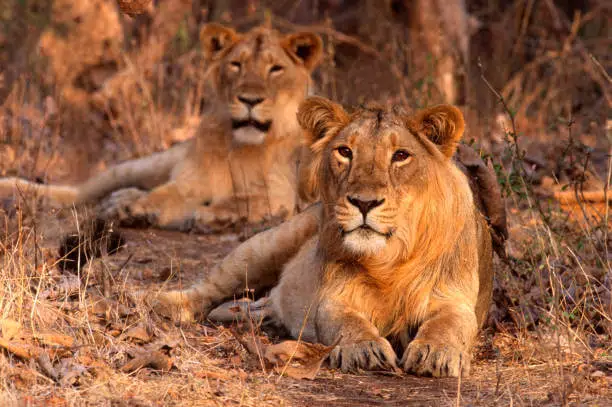
This lion is the rarest in the world today.
One lion species stands out as the Panthera Leo. The two subspecies breeds of lions are said to include the African lion or Panthera Leo and the Asiatic lion. The following is the list of lions in the world.
- Asiatic Lion (the rarest lion in the world now makes their home at Chester Zoo)Abyssinian Lion
- African Lion and Lioness
- Katanga Lion or Southwest African Lion
- White Lion
- Masai Lion or Serengeti Lion, in addition to the Somali and Kalahari Lion
There are several likenesses in all types of lions such as, all breeds of lions, like the Asiatic Lion, live in a pride. They are all close-knit and affectionate to one another. They all raise their cubs similarly, and the lionesses are the hunters of all species. The differences come in the development of the fur and the color of the fur. The height, weight, length, fur type, and color may differ slightly from species to species.
The scientific name for the Asiatic Lion is Panthera Leo Persica. This animal is a meat eater that lives to the age of at least 16 or more years. This majestic animal reaches 300 to 500 pounds, and its size is comparable to a six-foot man. The male lions develop stately manes around their head.
The Asiatic is home in the sub-Saharan African domain, while a few others of the same species are found in India’s Gir Forest. Those found in the Gir Forest are heavily protected due to being at a high risk of extinction. There are only a few of these types of lions left in the wild.
These species of lions also live in family unit groups known as pride. Prides host up to twelve or more related females who work together on hunts. There may be up to three males, including all the young. The males defend their territory and mark their territory with urine. As the young grow, they may leave the unit and find their pride.
#2. The African Lion and Lioness
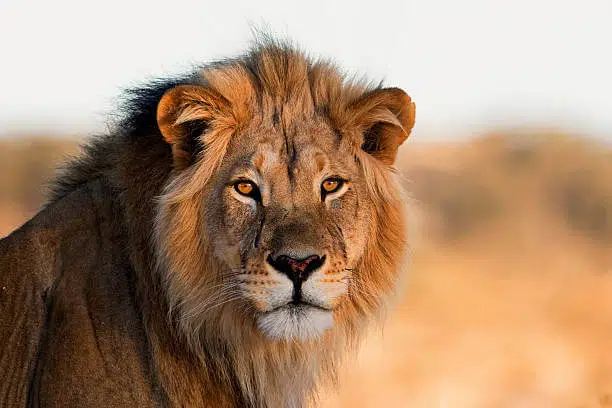
These lions have a lot going against them to live healthy and joyous lives in their wild habitat.
Males:
- Length 4.5-10.8-feet
- Tallness 3.9-feet
- 265-420-pounds and slightly heavier than a female
Females:
- Length 2.2-3.3-feet
- Tallness 3.6-feet
- Weight 265-420-pounds
The scrub, open woodlands, and grasslands in central and southern Africa are home to the African Lion and Lioness.
The African Lion is the second largest lion in the world. The male lion has an impressive, long, busy mane of hair covering the head and neck. This bushy hair serves as protection to the head and neck when the males are fighting. The general colors of this lion are a mixture of brown hues, combined with golden and blonde hair.
These types of lions, like their cousins, live in family units called prides. They call each other by roaring. Their roar is said to be heard at least five miles away. The African Lion and its family members are affectionate with one another.
These lions enjoy touching, purring, licking, and head rubbing. Interestingly, a male will stay within their pride for three to four years and leave. The female remains with pride as they age.
The female and male mate throughout the year and the gestation time for the lioness are three months. Females produce three to four cubs.
The African Lion and Lioness subsist on meat as their primary source of diet. This lion relies on meat from zebras, warthogs, antelopes, and other large prey. This lion enjoys hunting primarily at night but, on occasion, hunts during the daylight hours. These animals have great night vision.
The male and female lion’s lifespan is 8 to 15 years. The female generally lives longer than the male.
Reasons why the African Lion and Lioness are at Risk for Extinction
- Destruction and loss of habitat
- Poaching for furs
- Use in bravery rituals
- Trophy Hunters
- Medicinal Powers
- Ranch kills to protect livestock
- The spread of diseases such as tics, canine distemper, and babesia.
#3. Katanga Lion (Southwest African Lion)
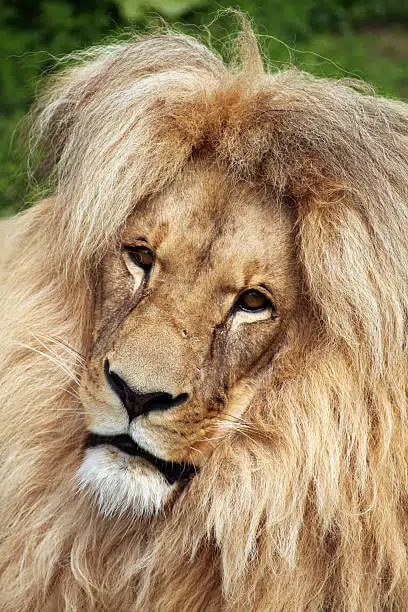
These lions are one of the largest lion species known.
While some researchers believe that all lions come from a single species, other researchers believe that lion species must be broken down into subspecies. These species find their home in one of the areas listed.
One of the largest lion species is the Katanga lion or Southwest African Lion. This lion makes its home in several different areas, such as the following locations:
- Western Zimbabwe
- Zambia
- Zaire
- Northern Botswana
- Angola
- Namibia
These types of lions are designated as truly the Kings of the Jungle. This lion makes its home in family units or prides and works hard to protect its family’s pride.
They have a distinctive mane of hair around the head and neck. It is the female lioness of the family that does the hunting. When the cubs reach a year of age, they are taught to hunt. Meat sustains these lions, lionesses, and their cubs from kills made on warthogs, zebras, and antelopes.
#4. White Lion
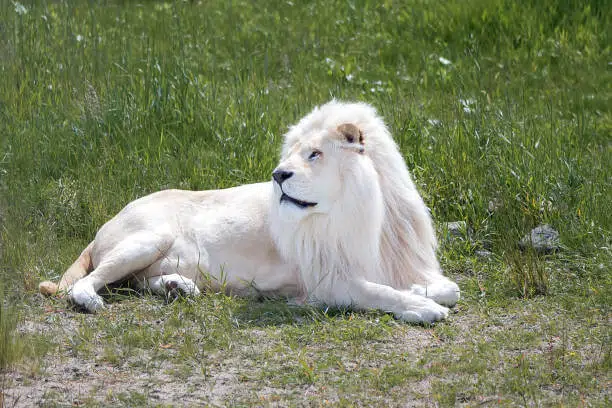
Anyone with a heart for wildlife, especially the lion community would feel heartbreaking for the White Lion and what they must endure.
The story of these majestic creatures is a sad story to those who love these animals. Hearts go out to each White Lion who can no longer be free to roam or at least be protected in a secure natural environment. White lions in the wild are searched for with the primary goal of protecting and securing these types of lions.
The species of Panthera Leo has a rare genetic offspring called the White Lion. Scientists found a recessive gene in this species. The White Lion is home in only one place, the Timbavati and Kruger areas.
However, in current times, White Lions are mostly found and held captive in zoos and circuses worldwide. Some too many zoos and circuses do not take the best care of these lions, thus many suffer at the hands of their keepers.
As far as White lions being at high risk for extinction, some scientists attest to this fact while other scientists claim this is fictional. Most agree that there is a lot of misinformation in the public realm regarding the White lion.
Hunting of these lions within our borders is illegal. However, hunters find loopholes. Individuals commercially hunt these majestic animals in their natural habitat or speed breed them in captivity only to become victims of the Canned Hunting arena.
Due to these circumstances, fewer than two dozen White Lions are roaming freely in their natural habitat. There are hundreds more living in captivity.
Reputable organizations are working hard to free and preserve the White Lion from its captives. These wonderful people who have a heart for the White Lion work with organizations to restore the number, health, and prosperity of the White Lion’s natural kingdom. Steps are being taken to,
- Upgrade protective systems around the natural habitat of the White Lion
- Strict protection from poachers
- Increasing landmass to accommodate this species for the benefit of pride.
- Increasing educational programs for adults and children
- Developing innovative ways in which to observe the security of these animals
- Utilizing tracking systems
Lions are the color they are to hide in the tall grasslands. However, this is not so for the White Lion, as they really stick out and do not hide well in their natural environment from predators and hunters.
Zoologists for a garden zoo in Italy find that the White Lion females do not do well breeding in captivity. Cubs are either stillborn or have a low survival rate beyond the first month. Many of these cubs are born with deformities and abnormalities of physical or neurological orientation.
#5. Masai Lion
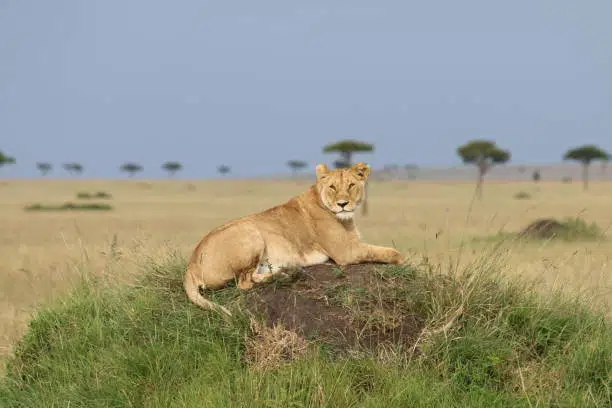
The Masai lion also called the East African lion or Panthera leo nubica is a lion species found in eastern Africa or Nubia.
These types of lions have the ability to adapt to their environment at high or low altitudes.
These types of lions have been described as having longer legs, and their bodies are less stocky or plump. Their backs do not appear as curved as other lion species. The males have tufts of fur on their knees. While the males have manes, they are not as full and look backward combed.
The manes appear more incredible as the lion ages. It all depends on the altitude of the habitat of this lion because the higher the habitat is, the fuller the mane becomes. The lower the habitat, such as in northern Kenya, where the climate is more humid and warmer, the mane is not as full. Sometimes, the manes are absent.
Areas called home to the Masai include northern Uganda, Kavirondo, southern Kenya, Lake Manyara, Mount Kilimanjaro, and Tanga.
Males:
- Length: 8.2-9.8 feet long from tail tip to head
- Height: 3-3.6-feet
- Weight: 320-452 pounds
Females:
- 7.5-8.5 feet long from tail tip to head
- Height: 3-3.6 feet
- Weight: 220-264 pounds
#6. The Abyssinian
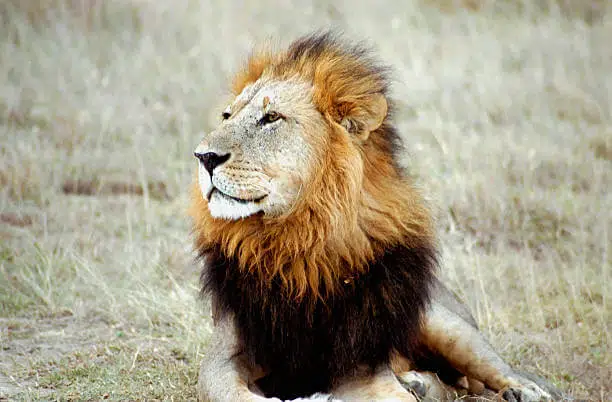
This lion type is a mystery to science and science is working hard to find the answers to their DNA
In 2012, scientists discovered that this lion species may be the last of a sub-species of the Abyssinian lion. These species are smaller, stocker, and have longer manes that continue under the torso and along the belly. DNA samples of this breed were taken, and it was discovered that no other lion species have the same DNA. This was a published article in the European Journal of Wildlife Research.
These lions are found as a descendant of the original five male and two female lions in 1948 at a private zoo. The zoo owner, Emperor Haile Selassie, claimed that the lions originally came from southwestern Ethiopia. Scientists are in search of similar species populations in the wild.
The lions reside in captivity in a small Addis Ababa, Ethiopia animal park. Unlike most lions, this species is shorter, and the males have distinctive black manes. The manes extend from the shoulders to the stomachs.
These lions also carry unique and rare DNA. Research teams believe these types of lions need further conservation efforts after the team ran 15 DNA tests on 20 of the zoo’s lions.
The results showed that their DNA was distinctly different than other African lions. The remaining five lions were not tested due to their young age. DNA results showed,
- These lions were genetically different.
- Phenotypically unique
- Had different behaviors than other African lions
- Showed no signs of inbreeding
- All descendants from the original lions from 1948
Researchers all believe that their genetic heritage should be preserved as much as possible. All believe these lions are a one-of-a-kind breed. A preservation program is in the planning stages.
- Establish a formal breeding program in captivity for these types of lions
- More room in the zoo is needed for a successful breeding program, and plans are in motion to expand the zoo.
- Devise a more natural habitat for these lions
- Closely monitor and improve policies and procedures affecting new cubs born in captivity and adult lions and lionesses’ overall treatment.
What type of lion is the biggest?
The biggest type of lion is the African lion (Panthera Leo). African lions are the largest big cats and can weigh up to 550 pounds. They are found primarily in sub-Saharan Africa and are known for their distinctive manes, unique to male lions.
Which lion is the strongest?
African lions are known for their strength and are the largest of the African big cats. They are apex predators and can take down prey much larger than themselves, making them one of the strongest big cats in the world. However, within the African lion population, the strongest lion can vary depending on age, size, and experience.
Frequently Asked Questions (FAQs)
How many types of lions are there?
Many different types and species of animals are categorized, just like the king of the jungle. A lion is more than just a lion; it is a species of around seven interesting different types.
What types of lions are there?
The Asiatic, African Lion and Lioness, Katanga Lion, White Lion, Masai Lion, and Abyssinian Lion are the seven breeds of lions.
What are the 7 species of lions?
There is only one species of lion, which is scientifically known as Panthera leo. However, there are several subspecies of lions that are recognized by scientists, each with distinct physical and behavioral characteristics. These subspecies include the Barbary lion, West African lion, Asiatic lion, Nubian lion, Masai lion, East African lion, and South African lion.
What is the rarest lion?
The rarest lion is the Asiatic lion. It is a subspecies of lion found only in the Gir Forest of India. Asiatic lions are listed as endangered, with only around 500 individuals remaining in the wild



How many types of bear
ReplyDelete